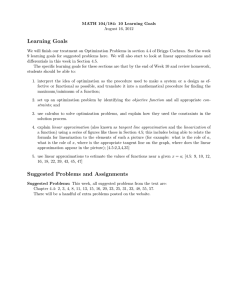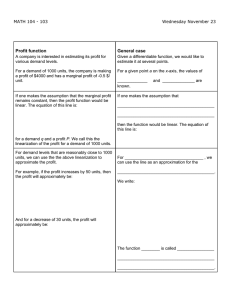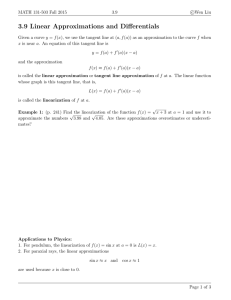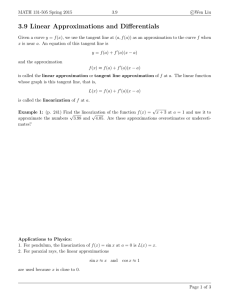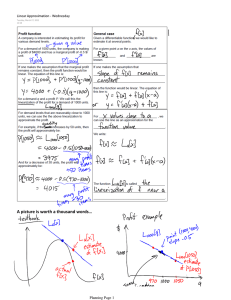Linear Approximations and Differentials
advertisement
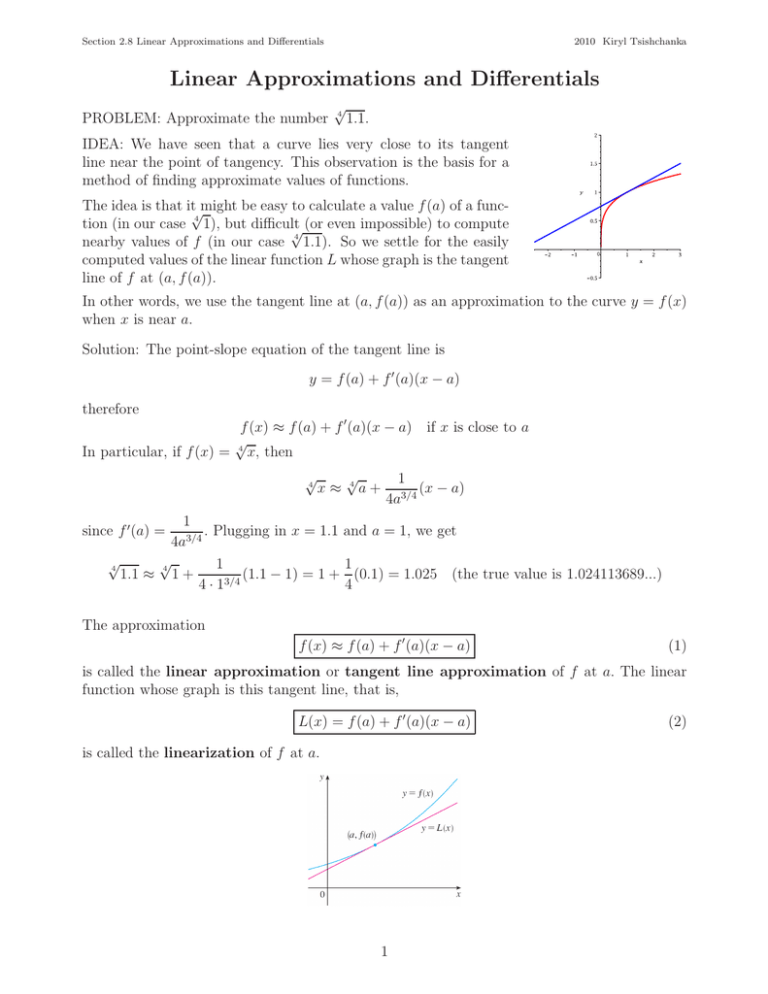
Section 2.8 Linear Approximations and Differentials 2010 Kiryl Tsishchanka Linear Approximations and Differentials PROBLEM: Approximate the number √ 4 1.1. IDEA: We have seen that a curve lies very close to its tangent line near the point of tangency. This observation is the basis for a method of finding approximate values of functions. The idea is that it√might be easy to calculate a value f (a) of a function (in our case 4 1), but difficult (or even impossible) to compute √ 4 nearby values of f (in our case 1.1). So we settle for the easily computed values of the linear function L whose graph is the tangent line of f at (a, f (a)). In other words, we use the tangent line at (a, f (a)) as an approximation to the curve y = f (x) when x is near a. Solution: The point-slope equation of the tangent line is y = f (a) + f ′ (a)(x − a) therefore f (x) ≈ f (a) + f ′ (a)(x − a) if x is close to a √ In particular, if f (x) = 4 x, then √ 4 x≈ √ 4 a+ 1 (x − a) 4a3/4 1 . Plugging in x = 1.1 and a = 1, we get 4a3/4 √ √ 1 1 4 4 (1.1 − 1) = 1 + (0.1) = 1.025 (the true value is 1.024113689...) 1.1 ≈ 1 + 3/4 4·1 4 since f ′ (a) = The approximation f (x) ≈ f (a) + f ′ (a)(x − a) (1) is called the linear approximation or tangent line approximation of f at a. The linear function whose graph is this tangent line, that is, L(x) = f (a) + f ′ (a)(x − a) is called the linearization of f at a. 1 (2) Section 2.8 Linear Approximations and Differentials 2010 Kiryl Tsishchanka √ EXAMPLE: Find the linearization of the function f (x) = x + 3 at a = 1 and use it to √ √ approximate the numbers 3.98 and 4.05. Are these approximations overestimates or underestimates? √ Solution: The derivative of f (x) = x + 3 is f ′ (x) = (x + 3)1/2 ′ 1 1 1 = (x + 3)1/2−1 · (x + 3)′ = (x + 3)−1/2 · 1 = √ 2 2 2 x+3 and so we have f (1) = 2 and f ′ (1) = 14 . Putting these values into (2), we see that the linearization is 7 x 1 L(x) = f (1) + f ′ (1)(x − 1) = 2 + (x − 1) = + 4 4 4 The corresponding linear approximation (1) is √ x+3 ≈ 7 x + 4 4 (when x is near 1) In particular, we have √ 3.98 ≈ √ 7 0.98 7 1.05 4.05 ≈ + + = 1.995 and = 2.0125 4 4 4 4 (3) The linear approximation is illustrated in the figure below. We see that, indeed, the tangent line approximation is a good approximation to the given function when x is near 1. We also see that our approximations are overestimates because the tangent line lies above the curve. √ √ Of course, a calculator could give us approximations for 3.98 and 4.05, but the linear approximation gives an approximation over an entire interval. In the table above we compare estimates from the obtained linear approximation with the true values. Notice from this table, and also from the figure above, that the tangent line approximation gives good estimates when x is close to 1 but the accuracy of the approximation deteriorates when x is farther away from 1. √ EXAMPLE: Find of the function f (x) = x at a = 4 and use it to approximate √ √ the linearization the numbers 3.98 and 4.05. Are these approximations overestimates or underestimates? 2 Section 2.8 Linear Approximations and Differentials 2010 Kiryl Tsishchanka √ EXAMPLE: Find the linearization of the function f (x) = x at a = 4 and use it to approximate √ √ the numbers 3.98 and 4.05. Are these approximations overestimates or underestimates? √ Solution: The derivative of f (x) = x is f ′ (x) = x1/2 ′ 1 1 1 = x1/2−1 = x−1/2 = √ 2 2 2 x and so we have f (4) = 2 and f ′ (4) = 14 . Putting these values into (2), we see that the linearization is x 1 L(x) = f (4) + f ′ (4)(x − 4) = 2 + (x − 4) = 1 + 4 4 The corresponding linear approximation (1) is √ x≈1+ x 4 (when x is near 4) In particular, we have √ 3.98 ≈ 1 + √ 3.98 4.05 = 1.995 and = 2.0125 4.05 ≈ 1 + 4 4 Note that we got the same results as in (3) since 1+ 3.98 3 + 0.98 3 0.98 7 0.98 =1+ =1+ + = + 4 4 4 4 4 4 1+ 3 + 1.05 3 1.05 7 1.05 4.05 =1+ =1+ + = + 4 4 4 4 4 4 and or, in general, x 3+x−3 3 x−3 7 x−3 =1+ =1+ + = + 4 4 4 4 4 4 Our approximations are overestimates because the tangent line lies above the curve. 1+ √ 3 EXAMPLE: Find the linearization of the function f (x) = 1 + x at a = 0 and use it to √ √ approximate the numbers 3 0.95 and 3 1.1. Are these approximations overestimates or underestimates? 3 Section 2.8 Linear Approximations and Differentials 2010 Kiryl Tsishchanka √ 3 EXAMPLE: Find the linearization of the function f (x) = 1 + x at a = 0 and use it to √ √ approximate the numbers 3 0.95 and 3 1.1. Are these approximations overestimates or underestimates? √ Solution: The derivative of f (x) = 3 1 + x is ′ 1 1 1 f ′ (x) = (1 + x)1/3 = (1 + x)1/3−1 · (1 + x)′ = (1 + x)−2/3 · 1 = p 3 3 3 3 (1 + x)2 and so we have f (0) = 1 and f ′ (0) = 31 . Putting these values into (2), we see that the linearization is x L(x) = f (0) + f ′ (0)(x − 0) = 1 + 3 The corresponding linear approximation (1) is √ x 3 (when x is near 0) 1+x≈1+ 3 In particular, we have √ −0.05 3 0.95 ≈ 1 + = 0.9833... (the true value is 0.9830475725...) 3 and √ 0.1 3 = 1.0333... (the true value is 1.032280115...) 1.1 ≈ 1 + 3 Our approximations are overestimates because the tangent line lies above the curve. √ EXAMPLE: Find the linearization of the function f (x) = 3 x at a = 1 and use it to approximate √ √ the numbers 3 0.95 and 3 1.1. Are these approximations overestimates or underestimates? √ Solution: The derivative of f (x) = 3 x is ′ 1 1 1 f ′ (x) = x1/3 = x1/3−1 = x−2/3 = √ 3 3 3 3 x2 and so we have f (1) = 1 and f ′ (1) = 13 . Putting these values into (2), we see that the linearization is x−1 2 x L(x) = f (1) + f ′ (1)(x − 1) = 1 + = + 3 3 3 The corresponding linear approximation (1) is √ 2 x 3 x≈ + (when x is near 1) 3 3 In particular, we have √ 2 0.95 3 = 0.9833... (the true value is 0.9830475725...) 0.95 ≈ + 3 3 and √ 2 1.1 3 1.1 ≈ + = 1.0333... (the true value is 1.032280115...) 3 3 EXAMPLE: Find the linearization of the function f (x) = sin x at a = 0 and use it to approximate the numbers sin(−0.1) and sin(0.1). Are these approximations overestimates or underestimates? 4 Section 2.8 Linear Approximations and Differentials 2010 Kiryl Tsishchanka EXAMPLE: Find the linearization of the function f (x) = sin x at a = 0 and use it to approximate the numbers sin(−0.1) and sin(0.1). Are these approximations overestimates or underestimates? Solution: The derivative of f (x) = sin x is f ′ (x) = (sin x)′ = cos x and so we have f (0) = 0 and f ′ (0) = 1. Putting these values into (2), we see that the linearization is L(x) = f (0) + f ′ (0)(x − 0) = 0 + 1 · (x − 0) = x The corresponding linear approximation (1) is sin x ≈ x (when x is near 0) In particular, we have sin(−0.1) ≈ −0.1 (the true value is -0.09983341665...) and sin(0.1) ≈ 0.1 (the true value is 0.09983341665...) The first approximation is an underestimate because the tangent line lies below the curve when x is near 0 from the left. The second approximation is an overestimate because the tangent line lies above the curve when x is near 0 from the right. EXAMPLE: For what values of x is the linear approximation sin x ≈ x accurate to within 0.1? Solution: Accuracy to within 0.1 means that the functions should differ by less than 0.1: | sin x − x| < 0.1 ⇐⇒ −0.1 < sin x − x < 0.1 Using a graphing calculator we can conclude that the approximation sin x ≈ x is accurate to within 0.1 when −0.86 < x < 0.86. 5 Section 2.8 Linear Approximations and Differentials 2010 Kiryl Tsishchanka Differentials The ideas behind linear approximations are sometimes formulated in the terminology and notation of differentials. If y = f (x), where f is a differentiable function, then the differential dx is an independent variable; that is, dx can be given the value of any real number. The differential dy is then defined in terms of dx by the equation dy = f ′ (x)dx So dy is a dependent variable; it depends on the values of x and dx. If dx is given a specific value and x is taken to be some specific number in the domain of f, then the numerical value of dy is determined. Let P (x, f (x)) and Q(x + ∆x, f (x + ∆x)) be points on the graph of f and let dx = ∆x. The corresponding change in y is ∆y = f (x + ∆x) − f (x) The slope of the tangent line P R is the derivative f ′ (x). Thus the directed distance from S to R is f ′ (x)dx = dy. Therefore, dy represents the amount that the tangent line rises or falls (the change in the linearization), whereas ∆y represents the amount that the curve y = f (x) rises or falls when x changes by an amount dx. Notice that the approximation ∆y ≈ dy becomes better as ∆x becomes smaller. If we let dx = x − a, then x = a + dx and we can rewrite the linear approximation (1) f (x) ≈ f (a) + f ′ (a)(x − a) in the notation of differentials: f (a + dx) ≈ f (a) + dy √ For instance, for the function f (x) = x + 3 in Example 1, we have dx dy = f ′ (x)dx = √ 2 x+3 If a = 1 and dx = ∆x = 0.05, then 0.05 = 0.0125 dy = √ 2 1+3 and √ 4.05 = f (1.05) ≈ f (1) + dy = 2.0125 just as we found in Example 1. 6

